Citroen DS5 HYBRID4 RHD 2011.5 1.G Owner's Manual
Manufacturer: CITROEN, Model Year: 2011.5, Model line: DS5 HYBRID4 RHD, Model: Citroen DS5 HYBRID4 RHD 2011.5 1.GPages: 358, PDF Size: 10.77 MB
Page 141 of 358
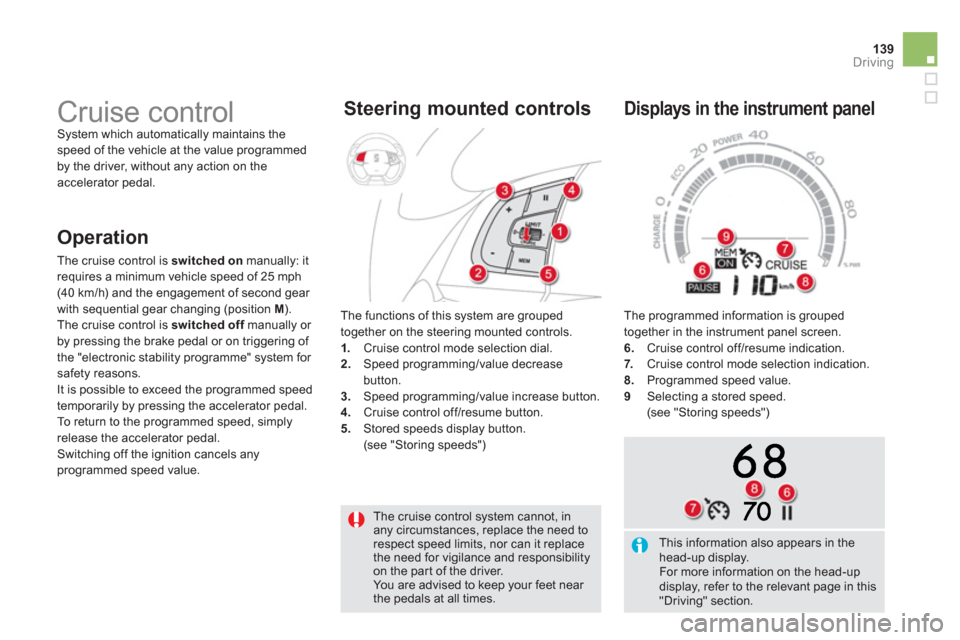
139Driving
The cruise control system cannot, in any circumstances, replace the need to respect speed limits, nor can it replacethe need for vigilance and responsibility on the par t of the driver. You are advised to keep your feet near the pedals at all times.
Cruise control System which automatically maintains thespeed of the vehicle at the value programmed
by the driver, without any action on the
accelerator
pedal.
The functions of this s
ystem are grouped
together on the steering mounted controls. 1.Cruise control mode selection dial.2. Speed programming/value decreasebutton.3.
Speed programming/value increase button.4.
Cruise control off/resume button.
5. Stored speeds display button.(see "Storing speeds")
Steering mounted controls
The programmed information is grouped
together in the instrument panel screen.
6. Cruise control off/resume indication.7.Cruise control mode selection indication. 8. Programmed speed value.9 Selecting a stored speed.
(see "Storing speeds")
Displays in the instrument panel
Operation
The cruise control is switched on
manually: it
requires a minimum vehicle speed of 25 mph (40 km/h) and the engagement of second gear
with sequential gear changing (position M ).
The cruise control is switched off
manually or fby pressing the brake pedal or on triggering of
the "electronic stability programme" system for safety reasons.
It is possible to exceed the programmed speed
temporarily by pressing the accelerator pedal.
To return to the programmed speed, simply
release the accelerator pedal.
Switching off the ignition cancels any programmed speed value.
This information also appears in thehead-up display.
For more information on the head-updisplay, refer to the relevant page in this"Driving" section.
Page 142 of 358
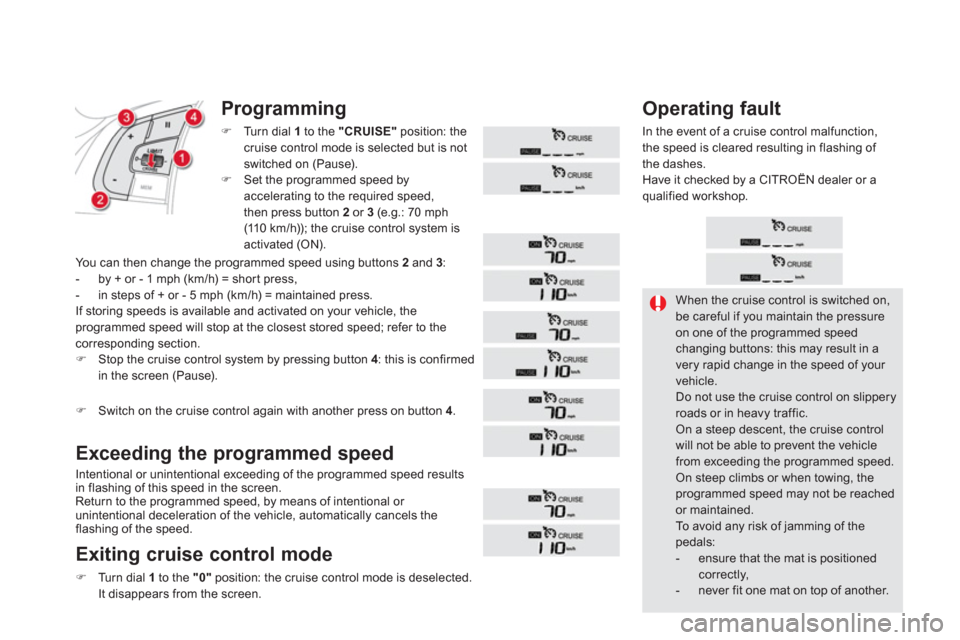
When the cruise control is switched on, be careful if you maintain the pressure on one of the programmed speed changing buttons: this may result in a very rapid change in the speed of your vehicle. Do not use the cruise control on slipperyroads or in heavy traffic. On a steep descent, the cruise control will not be able to prevent the vehiclefrom exceeding the programmed speed. On steep climbs or when towing, the programmed speed may not be reached or maintained.
To a v o i d a ny risk of jamming of the
pedals:
- ensure that the mat is positioned correctly,
- never fit one mat on top of another.
Programming
�)
Turn dial 1to the "CRUISE"
position: thecruise control mode is selected but is not
switched on (Pause).�)
Set the programmed speed byaccelerating to the required speed,
then press button 2 or 3
(e.g.: 70 mph(11 0 k m/h)); the cruise control system is
activated (ON).
Exceeding the programmed speed
Intentional or unintentional exceeding of the programmed speed results
in flashing of this speed in the screen.
Return to the programmed speed, by means of intentional or
unintentional deceleration of the vehicle, automatically cancels theflashing of the speed.
Exiting cruise control mode
�)Turn dial 1 to the "0"
position: the cruise control mode is deselected.
It disappears
from the screen.
�)Switch on the cruise control again with another press on button 4
.
Operating fault
In the event of a cruise control malfunction,
the speed is cleared resulting in flashing of
the dashes.
Have it checked by a CITROËN dealer or a qualified workshop.
You can then change the programmed speed using buttons 2
and 3:- by + or - 1 mph (km/h) = shor t press,
- in steps of + or - 5 mph (km/h) = maintained press.
If storing speeds is available and activated on your vehicle, theprogrammed speed will stop at the closest stored speed; refer to thecorresponding section.�)Stop the cruise control system by pressing button 4: this is confirmed in the screen (Pause).
Page 143 of 358
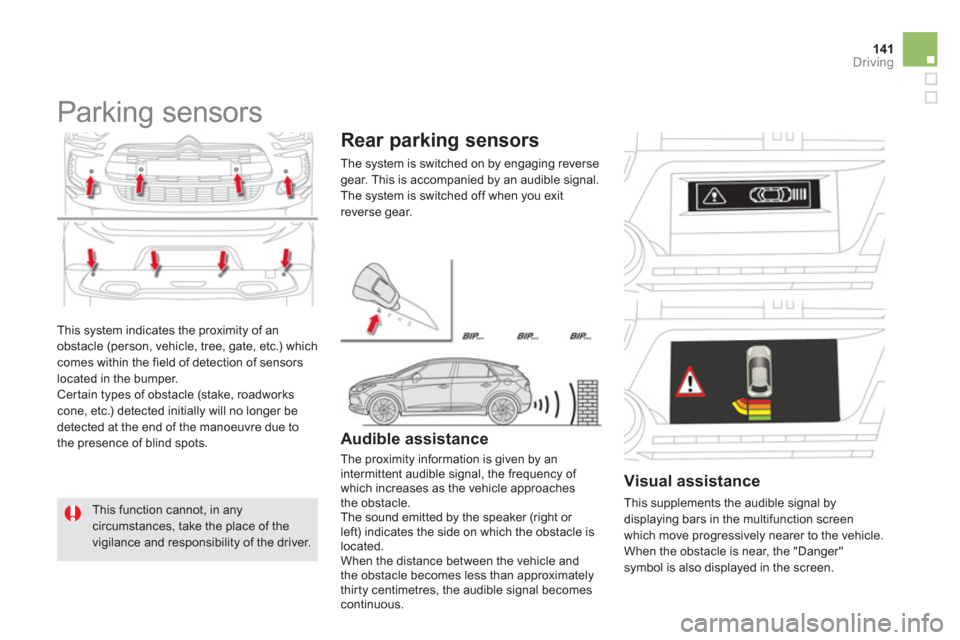
141Driving
This system indicates the proximity of an
obstacle (person, vehicle, tree, gate, etc.) which comes within the field of detection of sensorslocated in the bumper.
Certain types of obstacle (stake, roadworkscone, etc.) detected initially will no longer bedetected at the end of the manoeuvre due to
the presence of blind spots.
Parking sensors
This function cannot, in any circumstances, take the place of the vigilance and responsibility of the driver.
Rear parking sensors
The system is switched on by engaging reversegear. This is accompanied by an audible signal.
The system is switched off when you exit reverse gear.
Audible assistance
The proximity information is given by anintermittent audible signal, the frequency of which increases as the vehicle approaches
the obstacle.
The sound emitted by the speaker (right or left) indicates the side on which the obstacle islocated. When the distance between the vehicle andthe obstacle becomes less than approximately
thirty centimetres, the audible signal becomescontinuous.
Visual assistance
This supplements the audible signal bydisplaying bars in the multifunction screen
w
hich move progressively nearer to the vehicle.When the obstacle is near, the "Danger" symbol is also displayed in the screen.
Page 144 of 358
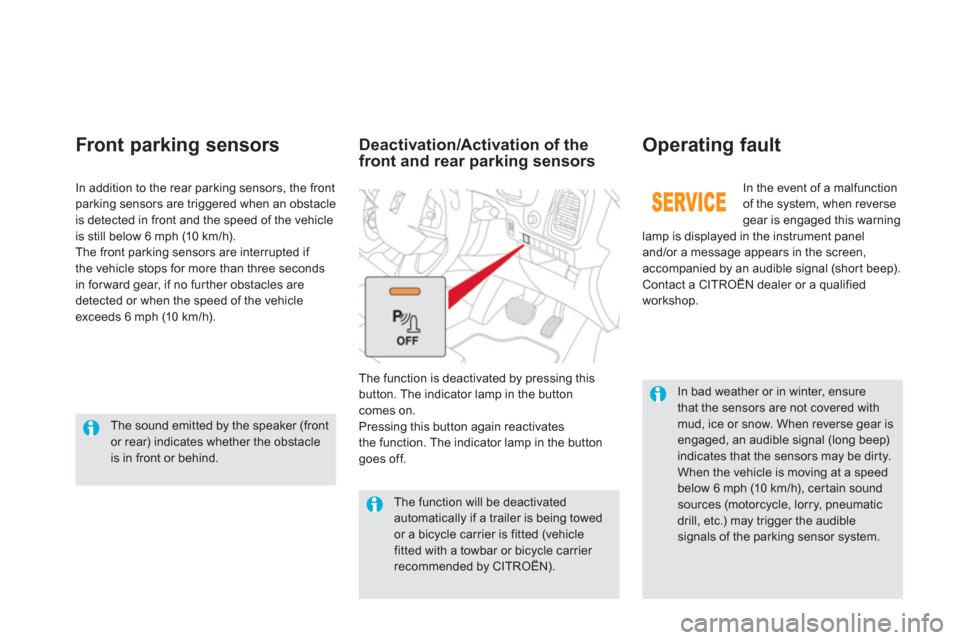
In bad weather or in winter, ensure that the sensors are not covered with mud, ice or snow. When reverse gear is
engaged, an audible signal (long beep)indicates that the sensors may be dirty.
When the vehicle is moving at a speed below 6 mph (10 km/h), cer tain sound sources (motorcycle, lorry, pneumatic drill, etc.) may trigger the audiblesignals of the parking sensor system.
In th
e event of a malfunctionof the system, when reverse gear is engaged this warning
lamp is displayed in the instrument paneland/or a message appears in the screen,
accompanied by an audible signal (short beep).
Contact a CITROËN dealer or a qualified
workshop.
Operating fault
In addition to the rear parking sensors, the front parking sensors are triggered when an obstacle
is detected in front and the speed of the vehicle
is still below 6 mph (10 km/h).
The front parking sensors are interrupted if
the vehicle stops for more than three seconds
in for ward
gear, if no fur ther obstacles are
detected or when the speed of the vehicle
exceeds 6 mph (10 km/h).
Front par king sensors
The function will be deactivated automatically if a trailer is being towed or a bicycle carrier is fitted (vehicle fitted with a towbar or bicycle carrier recommended by CITROËN).
Deactivation/Activation of the front and rear parking sensors
The function is deactivated by pressing thisbutton. The indicator lamp in the button comes on.
Pressing this button again reactivates
the function. The indicator lamp in the button
goes off.
The sound emitted by the speaker (front
or rear) indicates whether the obstacle is in front or behind.
Page 145 of 358
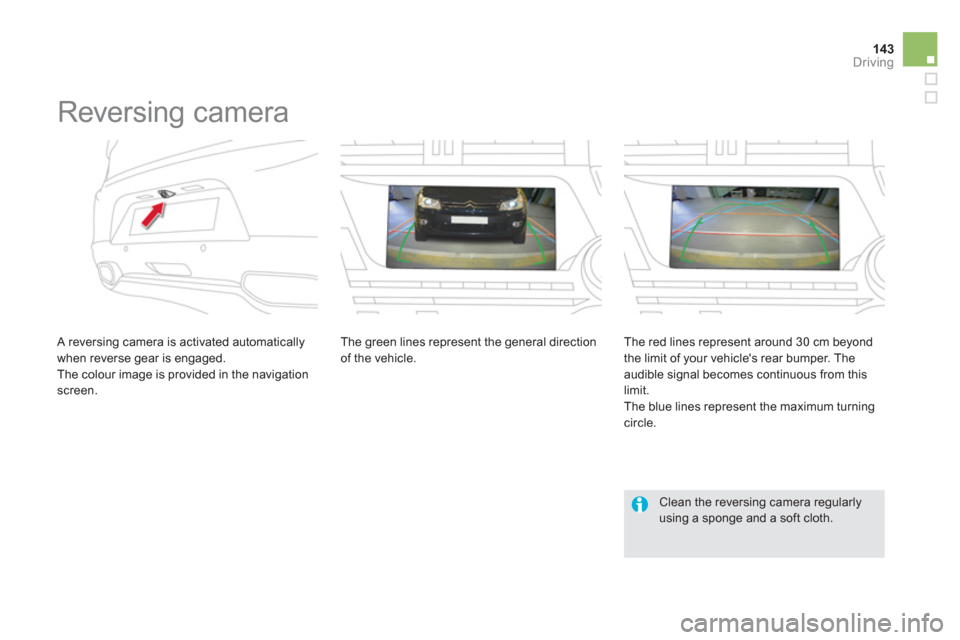
143Driving
Reversing camera
A reversing camera is activated automatically
when reverse gear is engaged.
The colour image is provided in the navigationscreen. The
green lines represent the general direction of the vehicle.
The red lines represent around 30 cm beyond
the limit of your vehicle's rear bumper. The
audible signal becomes continuous from thislimit.
The blue lines represent the maximum turningcircle.
Clean the reversing camera regularly using a sponge and a soft cloth.
Page 146 of 358

005
Visibility
Page 147 of 358
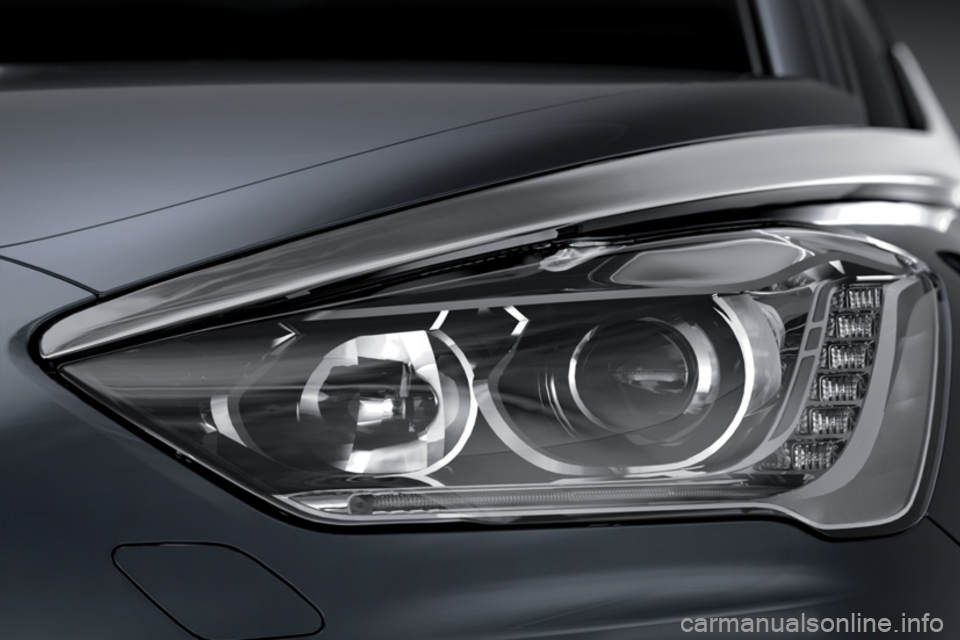
Page 148 of 358
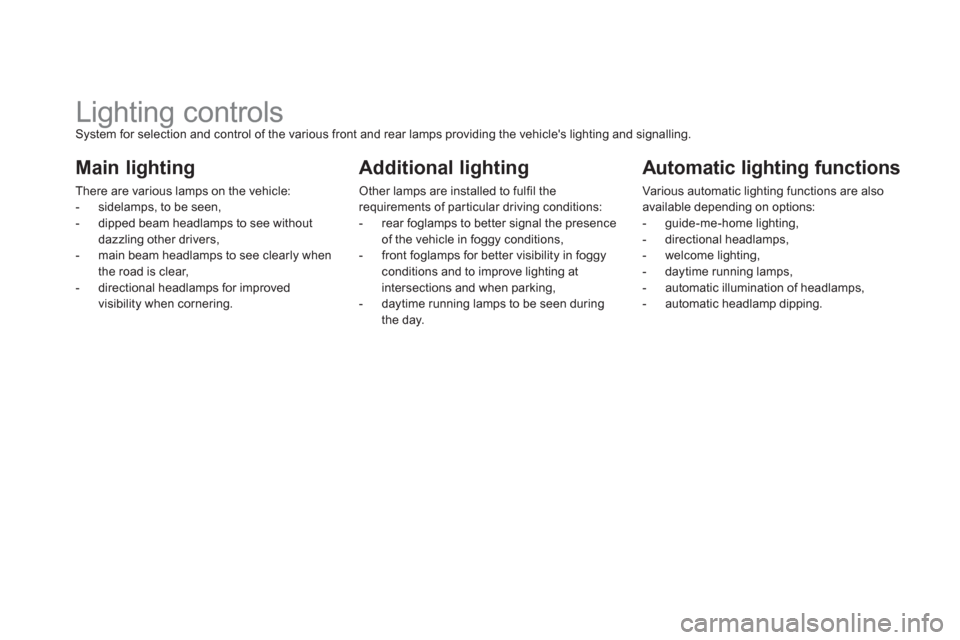
Lighting controls System for selection and control of the various front and rear lamps providing the vehicle's lighting and signalling.
Main lighting
There are various lamps on the vehicle:
- sidelamps, to be seen,
- dipped beam headlamps to see without
dazzling other drivers,
- main beam headlamps to see clearly when
the road is clear,
- directional headlamps for improved
v
isibility when cornering.
Additional lighting
Other lamps are installed to fulfil the requirements of par ticular driving conditions:
- rear foglamps to better signal the presence of the vehicle in foggy conditions,
- front foglamps for better visibility in foggyconditions and to improve lighting at
intersections and when parking,
- daytime running lamps to be seen duringthe day.
Automatic lighting functions
Various automatic lighting functions are also
available depending on options:
-
guide-me-home lighting,
- directional headlamps,
- welcome li
ghting,
- daytime running lamps,
- automatic illumination of headlamps,
- automat
ic headlamp dipping.
Page 149 of 358
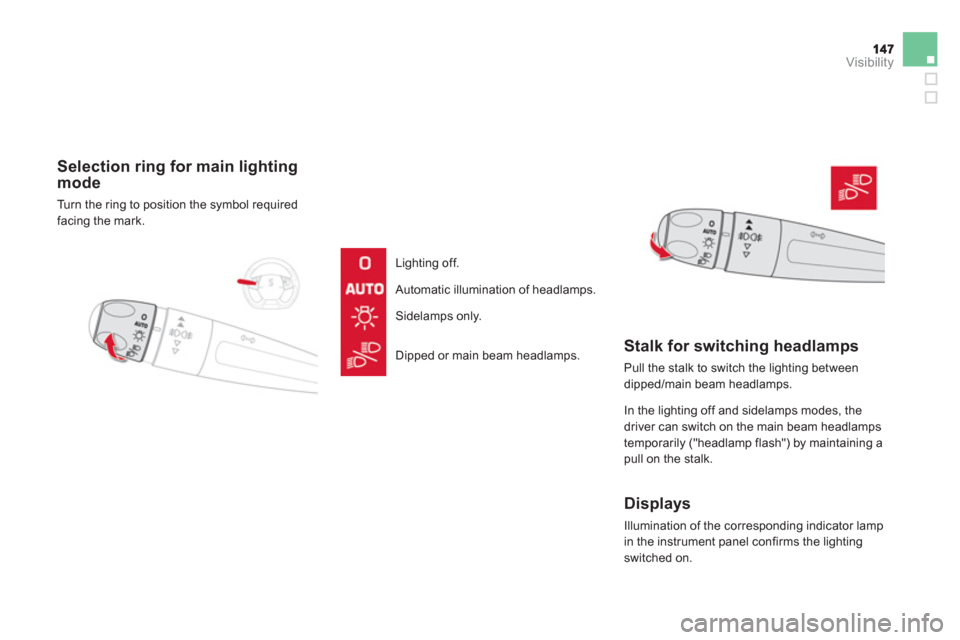
Visibility
Selection ring for main lighting mode
Turn the ring to position the symbol required
facing the mark.
Lighting o
ff.
Automatic illumination of headlamps.
Sidelamps only.
Dipped or main beam headlamps.
Stalk for switching headlamps
Pull the stalk to switch the lighting between
dipped/main beam headlamps.
In the li
ghting off and sidelamps modes, the
driver can switch on the main beam headlamps
temporarily ("headlamp flash") by maintaining a
pull on the stalk.
Displays
Illumination of the corresponding indicator lamp
in the instrument panel confirms the lighting switched on.
Page 150 of 358
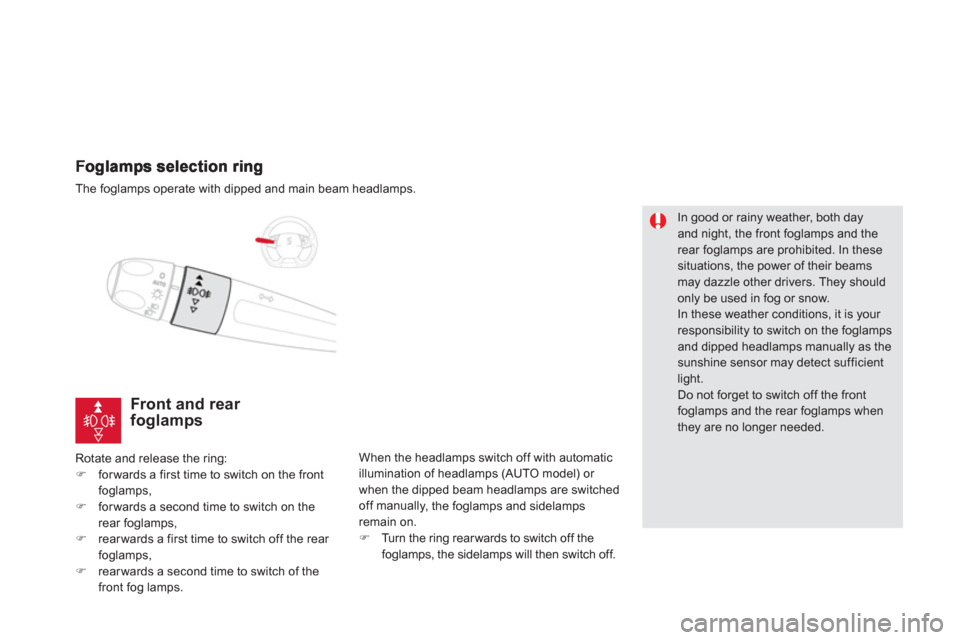
The foglamps operate with dipped and main beam headlamps.
Front and rearfoglamps
Rotate and release the ring: �)forwards a first time to switch on the frontfoglamps, �)forwards a second time to switch on therear foglamps, �)rearwards a first time to switch off the rear foglamps, �)rearwards a second time to switch of the
front fo
g lamps. When the headlamps switch off with automatic
illumination of headlamps
(AUTO model) or
when the dipped beam headlamps are switched
off manuall
y, the foglamps and sidelampsremain on.
�) Turn the ring rear wards to switch off thefoglamps, the sidelamps will then switch off.
In good or rainy weather, both day and night, the front foglamps and the rear foglamps are prohibited. In these situations, the power of their beams may dazzle other drivers. They shouldonly be used in fog or snow.
In these weather conditions, it is your responsibility to switch on the foglamps and dipped headlamps manually as the sunshine sensor may detect sufficientlight.
Do not forget to switch off the front foglamps and the rear foglamps when they are no longer needed.